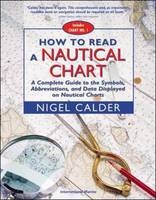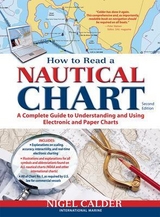
How to Read a Nautical Chart
McGraw-Hill Professional (Verlag)
978-0-07-137615-0 (ISBN)
- Titel erscheint in neuer Auflage
- Artikel merken
'Calder has done it again. This comprehensive and, as importantly, readable book on navigation should be required on all boats' - Peter Nielsen, editor, "SAIL" magazine. 'This is a wonderful chart companion: an intriguing investigation of chart development combined with practical, hands-on data on how to really put a chart to use' - Tim Queeney, editor, "Ocean Navigator Charts". Whether paper or electronic, they are your most fundamental navigational tool. Using them to your best advantage requires a thorough understanding of the symbols and abbreviations and an awareness of the limits of accuracy in positions and soundings. Did you know, for example, that hydrographic standards used to collect the majority of data on modern charts are considerably less accurate than GPS position fixes? That the majority of soundings still come from lead-line surveys? That a wreck symbol surrounded by a dotted circle means it is considered dangerous?That there are four different kinds of rock symbols, each with a different meaning? And that the definition of 'danger' has changed over time and will depend on the age of your charts?
In "How to Read a Nautical Chart", trusted boating authority Nigel Calder answers these and hundreds of other questions clearly and concisely. He covers in detail: fundamental chartmaking concepts in plain language; the limits of accuracy of modern charts (paper and electronic); dozens of full-scale illustrations from actual charts; expanded versions of U.S., British, and international chart symbology descriptions contained in NOAA's Chart No. 1, the British Admiralty's Chart 5011, and the IHO's INT-1; and much more.It presents essential information designed to improve vital chart-reading skills. "How to Read a Nautical Chart" should be on every navigator's bookshelf. 'Nigel's enthusiasm and insight turn a mundane chart into a map of buried treasure. Every navigator should stow a copy in the chart table' - Paul Gelder, deputy editor, "Yachting Monthly".
Niger Calder is the author of Marine Diesel Engines (1987, 1991) and Boatowner's Mechanical and Electrical Manual (1989, 1995), the success of which has made him the most sought-after marine how-to writer in the U.S. and U.K. He has published more than 800 magazine articles in SAIL, Cruising World, Ocean Navigator, Yachting World, etc., and lectures on cruising to sell-out crowds. He is also the author of The Cruising Guide to The Northwest Caribbean (IM, 1991) and Cuba: A Cruising Guide (Imray, 1996). He will be testing his newest ideas with his family during a six-month cruise to the Caribbean and South America this winter.
Acknowledgments and Art CreditsIntroductionPart 1. The Limits of AccuracyChapter 1. Fundamental Chart-Making ConceptsChapter 2. Horizontal Chart AccuracyChapter 3. Vertical Chart AccuracyPart 2. SymbologyChapter 4. Introduction to INT-1Chapter 5. TopographyChapter 6. HydrographyChapter 7. Aids and ServicesPart 3. AppendixIndex to INT-1Glossary and AcronymsCommon Chart AbbreviationsBibliographyGeneral Index
| Erscheint lt. Verlag | 16.9.2002 |
|---|---|
| Zusatzinfo | 500 Illustrations, unspecified |
| Sprache | englisch |
| Maße | 216 x 274 mm |
| Gewicht | 543 g |
| Themenwelt | Sachbuch/Ratgeber ► Sport ► Segeln / Tauchen / Wassersport |
| Technik ► Fahrzeugbau / Schiffbau | |
| ISBN-10 | 0-07-137615-1 / 0071376151 |
| ISBN-13 | 978-0-07-137615-0 / 9780071376150 |
| Zustand | Neuware |
| Haben Sie eine Frage zum Produkt? |
aus dem Bereich



